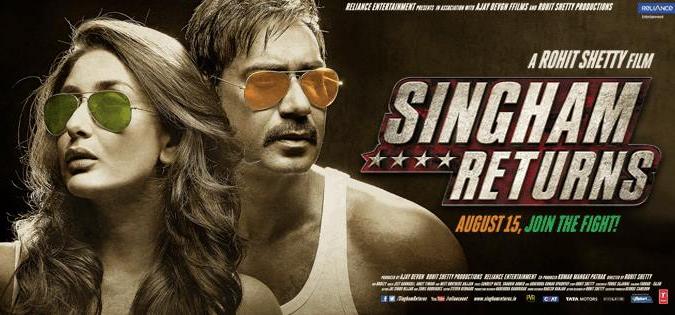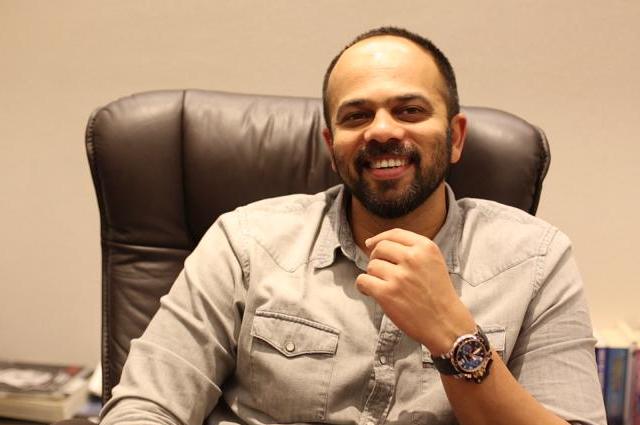What does one get when one of the leading VFX studios in the country comes together with one of India’s most commercially successful directors; well the answer is a roaring success at the Indian box-office in the form of Singham Returns.
As of now the Ajay Devgan and Kareena Kapoor Khan starrer has raked in over Rs 135 crore net at the domestic box office, Singham Returns has already made an entry in the list of top 10 highest-ever Bollywood grossing films ever.

But, a lot of effort went into creating this actioner – a sequel to the 2011 blockbuster hit Singham – once again helmed by Rohit Shetty. Some of the sequences which Reliance MediaWorks helped execute were the car explosion shots; the shoot-out on the Bandra-Worli Sea Link; and some major crowd multiplication shots among other day/night composites.
With a budget of nearly Rs 115 crore (inclusive of advertising cost as well as fees of the actors and the director) the movie released in nearly 4,000 screens across India on 15 August, 2014. It went onto create a record for the fourth highest opening day figure with Rs 30.43 crore, just behind Shetty’s other mega blockbuster of 2013 Chennai Express, which stands at Rs 30.48 crore.
AnimationXpress.com’s Niyati Handa caught up with Singham Returns’ director Rohit Shetty and Reliance MediaWorks’ creative head Naveen Paul to spill the beans on the making of the sequel and much more.
Excerpts:-
2,500 VFX shots is a huge number for a Bollywood movie, what triggered the use of such heavy duty VFX?
 Rohit Shetty: The film required heavy duty VFX work as it’s an out an out Bollywood action pot boiler; since all the technology is available at our disposal nowadays, it’s easier to pre-visualise the whole movie even before it goes on the floors. I have worked with the Reliance MediaWorks team on most of my earlier projects and I could only think of them to execute the VFX for the sequel to Singham as well.
Rohit Shetty: The film required heavy duty VFX work as it’s an out an out Bollywood action pot boiler; since all the technology is available at our disposal nowadays, it’s easier to pre-visualise the whole movie even before it goes on the floors. I have worked with the Reliance MediaWorks team on most of my earlier projects and I could only think of them to execute the VFX for the sequel to Singham as well.
Naveen Paul: At Reliance MediaWorks, we believe in working very closely with the director and producer of each film that we work on, as it streamlines the complete process and in-turn the team can also produce a better quality product which would be of a higher standard.
 The Indian VFX industry is learning from its Hollywood counterparts and improving on the way a sequence or a shot can be enhanced, but not coming in the way of the script. Rohit Shetty is among some of the few Indian film makers who is very open to exploring the various avenues through which VFX can be righty used to not only do justice to his film but also benefit the film industry overall.
The Indian VFX industry is learning from its Hollywood counterparts and improving on the way a sequence or a shot can be enhanced, but not coming in the way of the script. Rohit Shetty is among some of the few Indian film makers who is very open to exploring the various avenues through which VFX can be righty used to not only do justice to his film but also benefit the film industry overall.
Which were the shots that required a lot of brainstorming and time?
Rohit Shetty: If one has a person on the set who really understands how best VFX can be used to enhance and create an experience which is as real as it can get, then the job of the director becomes that much easier. We were lucky to have that guy in Naveen on the sets of Singham Returns.
The most difficult sequence (by far) would have to be the shoot-out on the Bandra-Worli Sea Link between Bajirao Singham along with his task force and the villain’s henchmen. At one moment I just gave up but Naveen kept reassuring me that he will make it happen, he was the one who built up that confidence in me, and finally we came up with a shot, which really brought life to that complete sequence.

Naveen Paul: The complete sequence took a lot of time and effort for the entire team, as it required a lot of effort in recreating the Bandra-Worli Sea Link. We started shooting for the film in the month of March 2014 but the VFX team started the previz work in December 2013 itself. The logistics was a major issue as the team could not manage to get permission for shooting on the sea-link, thus being the creative head all eyes were on me and people had lots of expectations on how would I manage this shot.
I requested Rohit to give me few days to do some research; post which I started doing a test on the Bandra-Worli Sea Link. Like for instance if the width of the bridge is 40 feet, we actually made a model of 40 feet in the software, so that it looked as realistic as the original. The height of the suspension wires from the road, and the number of cars that needed to be on the sea link, all were set accordingly. It took us 45 days to build the Bandra-Worli shot, but I am really pleased with the end result.
What is the importance of using VFX in films nowadays?
Rohit Shetty: If you are making a big film, if your canvas is large then VFX plays a very important role in that. It’s of great help; else I feel you can’t create that kind of a visual spectacle for your audience. Nowadays there is a lot of exposure to Hollywood films, so to come up to that level you need to have high standards of VFX.
People always say why we can’t make films like the West; the thing is that it’s all about the budget and time. Give me Rs 1,300 crore and I will create a Transformer for you with the Reliance team, it’s that simple. We have talented artists in India including the right technology, but the budget is the main hurdle. When we talk about Hollywood films, it caters only to one language, whole of USA, Europe and India as well, but when we come to our Hindi movies, it caters to only Mumbai and North India not even South India. For instance if we take Tamil Nadu, Karnataka or even Andhra Pradesh, all of them make their own films, so in total we are making movies with 10-15 different languages and that’s why our market is segmented as well. Our films are not released globally; some don’t even get a fully fledged India release.


Naveen Paul: At Reliance MediaWorks we set high benchmarks for ourselves; all the technicians like me would love to do good VFX work on the lines of a big Hollywood blockbuster. Every filmmaker nowadays is realising the importance of VFX and because now we have Hollywood films as ready reference; the industry demands for such grand movies and their expectations skyrocket. But I am sure five years down the line even the Bollywood industry will be able to make movies of such level. Krrish 3 and Ra.1 have already attempted to explore that space with great visual effects.
Sharing his thoughts on working with film makers from other industries he explained; as a company we don’t really focus on just working with Hindi film makers, we are open to working with people down south as well but they have their own studios there and have their comfort level.
So, what makes a ‘Rohit Shetty Film’ tick with the Indian audience?

Rohit Shetty: People always say (and think) that Rohit Shetty has made a film so it will definitely make Rs 100 crore at the box-office, but it doesn’t work that way. When we consider box-office returns it’s not really Rs 100 crore it’s actually Rs 50 crore or so, as half of the collections goes in taxes and people don’t think about it. We can try to reduce the tax, but in our country all states have their own taxation policies.
I’m currently writing a film starring Shah Rukh Khan; it’s in the planning stage as of now. We will start the shooting six months from now for a probable 2015 release. I take anywhere between six to seven months to finish my films, including VFX and CGI. Singham Returns took me four months; we started shooting for on 12 March, 2014 and it was released on 15 August.
Also, my movies do well because they are family friendly. When people watch my movies on TV they will never have to cringe and switch to other channel thinking “ke abhi kissing scene aayega ya fir kuch nude scene aayega” as I wouldn’t want my kid to see such films either.

